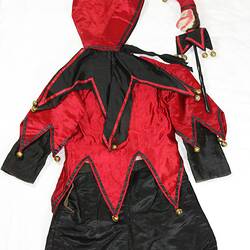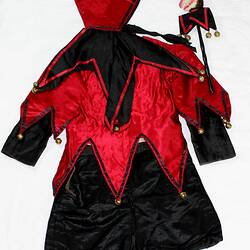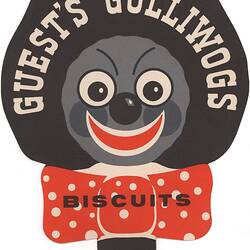Summary
Alternative Name(s): Court Jester Costume
Four-piece child's jester costume, comprising shorts with attached vest, top, jester's hat and sceptre. It dates to the mid to late 19th century and is said to come from the station 'Buangor' in western Victoria.
'Buangor' was established in 1849 by pastoralist and parliamentarian Colin Campbell (1817-1903), who was married to Frances Elliott Macwhirter (1827-1883) and later Emily Ashby Shieffield. He had 13 children, of whom nine survived him. The Campbell family lived in Gardiner (Malvern) for most of the 1850s - Campbell was Member of the Legislative Council for Ripon, Hampden and other electorates in 1854-59 - leaving the property to be managed by a David Clarke. Around 1859 they returned to 'Buangor', and were soon part of a growing community in the newly settled township of Buangor (established 1861). In 1864 Campbell sold the homestead to concentrate on standing for the Legislative Assembly seat of Ararat (he was unsuccessful on this occasion). In 1875 he re-purchased the property and took pride in the opening of the railway line to Buangor township in March 1875 as a local MLA. He became an ordained priest (Church of England) in 1878, and moved around Victorian parishes in that role. He re-sold 'Buangor' in 1885, at the age of 68. The station was eventually dismantled in November 1898.
The costume provides a rare insight into children's entertainment and play in a socially active 19th century rural community, whether used by Campbell family or others living at the estate. Buangor township soon became a socially active community, with locals organising regular balls, dances, theatre shows, tea parties, races and picnics where children's entertainment was arranged.
The jester's costume would have been used for role play, and possibly for theatrical performances. Jesters were sometimes associated with circuses - for instance, a 'jester to the performance' appeared during the intermission of a circus variety act at Malcom's Royal Australian Ampitheatre in Sydney on 8 August 1853 (Empire (Sydney), 8 August 1853, p.3).
Physical Description
Four-piece child's jester costume, comprising shorts with attached vest, top, jester's hat and sceptre. The outfit has been machine-sewn with hand-finishing. In some places the seams are bent, suggesting rough or rapid work. The shorts are black silk, lined with red fabric. They have drawstrings on the leg holes and at the waist. The leg holes show considerable wear. The shorts are sewn onto a sleeveless cream-coloured cotton vest with round neck and three cream-coloured buttons down the front, two fabric-covered and one of mother-of-pearl. Deep armholes to the front have been roughly hand-stitched - possibly they have been widened. The top is bright red silk, lined with red fabric. The waist and sleeves end in points, each trimmed with hand-sewn black tape and decorated with a brass bell (one is now missing from the hem). The sleeves terminate in black silk, extending from under the pointed ends of the sleeves. The top has an opening from its round neckline, down the proper right side to under the right arm, secured with black hooks and sewn eyeholes. The hat is made of red and black silk, trimmed with tape. The upper portion is black, and follows the shape of the head, terminating at the top with a single forward-facing hook, decorated with a brass bell. The hook shape is maintained with wool wadding, visible from the inside. The lower portion of the hat is red, and extends from the base of the neck into a black collar terminating in six points, each trimmed with hand-sewn red tape and decorated with a brass bell. A fastening tape would secure the hat at the chin. The mock sceptre (also known as a bauble or marotte) consists of small jester's head made of cream cloth, with exaggerated hooked nose, stitched eyes and red painted nose, chin and sideburns, and a piece of brown cloth to indicate hair. A hat on the jester's head is topped with a single forward-facing hook, decorated with a brass bell and probably stuffed with wool wadding. Below the neck is a black collar terminating in four points, each trimmed with red tape and decorated with a brass bell. The mock sceptre is mounted on a turned wood stick, painted black.
Significance
Statement of Signifiance:
The jester costume has multiple layers of significance. It provides a rare material record of children's entertainment and play in a socially active 19th century rural community. It is believed to have been used at 'Buangor', a 19th century homestead in western Victoria, established in 1849 by Colin Campbell and eventually dismantled in November 1898. From the 1860s onwards the local township of Buangor was a socially active community, with regular balls, dances, theatre shows, tea parties, races and picnics where children's entertainment was arranged.
The outfit shows considerable aesthetic/artistic significance, incorporating both hand and machine stitching. Evident is a high degree of creative accomplishment and attention to detail in order to create an accurate depiction of a court jester, such as the use of particular colours, fabrics, bells and hand-stitched designs to create the jester's face on the hand-stick. The detailing and use of varied fabrics, particularly satin, in the costume's production could signify the original owners' affluence. This is supported by historical records which show that families in Buangor and the surrounding districts were fairly prosperous, even during the 1890s economic depression.
The outfit's significance is further highlighted by several comparative criteria. After searching the collections of other public institutions in Australia and overseas, it seems that the costume is a rare item in Australia. The costume is in a fragile condition showing signs of wear, tear and repairs which suggests it was worn regularly. The outfit is fairly complete and contains the four main components of a jester's costume, namely the bodysuit, hat, jacket and hand-stick. Its interpretative capacity is fairly strong as it provides us with an early example of children's costuming and entertainment in rural Victoria. The costume is also compatible with the Museum's collection policy to record historical childhood experiences and clothing in Victoria. The policy notes in particular the scarcity of children's 19th century items within the museum's collection.
More Information
-
Collecting Areas
-
Acquisition Information
Donation from (Estate of) Maureen Christie, Art Gallery of Ballarat, Mr Gordon Morrison - Art Gallery of Ballarat, Jun 2010
-
Date Used
'Buangor' estate, Ballarat District, Victoria, Australia, 1849-1899
-
Classification
-
Category
-
Discipline
-
Type of item
-
Overall Dimensions
410 mm (Width), 545 mm (Height)
Shorts with sewn-in vest - laid flat
-
Overall Dimensions
825 mm (Width), 495 mm (Height)
Top - measured flat with sleeves extended
-
Overall Dimensions
50 mm (Width), 215 mm (Depth), 635 mm (Height)
Hat - when laid flat
-
Overall Dimensions
45 mm (Width), 105 mm (Depth), 382 mm (Height)
Mock sceptre
-
Keywords
Role Play, Children's Play, Clothing, Cultural Stereotypes, Fancy Dress



